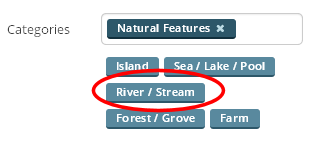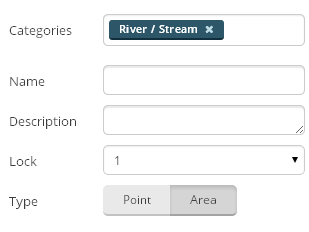Kentsmith9 (talk | contribs) (→Water Features not to Map: formatting to match Wiki style) |
m (→Introduction: spelling) |
||
| Line 3: | Line 3: | ||
== Introduction == | == Introduction == | ||
Many water features (lakes, rivers, etc.) are displayed on the Waze client to help | Many water features (lakes, rivers, etc.) are displayed on the Waze client to help spatial recognition of areas when navigating. They are displayed in a '''Map Water Layer''' that is not accessible by the Waze editing community and can take significant time to get updated by Waze staff. The Map Water Layer appears below other edited features on the map like roads and Area Places. | ||
There are locations where the Map Water Layer has inaccuracies including mapping water where it does not exist and omission of significant water areas. Also, some water features could be more useful to drivers if the name of the water feature was displayed on the map. | There are locations where the Map Water Layer has inaccuracies including mapping water where it does not exist and omission of significant water areas. Also, some water features could be more useful to drivers if the name of the water feature was displayed on the map. | ||
Latest revision as of 14:07, 22 August 2014
This is a draft page for discussion and development of a Wiki page about mapping water features. The forum discussion about this is here.
Introduction
Many water features (lakes, rivers, etc.) are displayed on the Waze client to help spatial recognition of areas when navigating. They are displayed in a Map Water Layer that is not accessible by the Waze editing community and can take significant time to get updated by Waze staff. The Map Water Layer appears below other edited features on the map like roads and Area Places.
There are locations where the Map Water Layer has inaccuracies including mapping water where it does not exist and omission of significant water areas. Also, some water features could be more useful to drivers if the name of the water feature was displayed on the map.
The Area Places layer can be used to augment some of these limitations in the Map Water Layer. Area Places will be displayed on the client app and therefore may be created to add needed water features where they are lacking and to also display names of those water features on the client app.
In considering what water features to map with Area Places, do not add unnecessary information to the map or information that would clutter the display. With that in mind, this guidance is provided to encourage a standard approach in using Area Places for water features.
Principles for mapping water features
There may be local preference or precedent in mapping water features. We hope that consensus and standardization will result from the following principles that indicate when we should and should not map water features.
- Do not map water features that already exist on the Map Water Layer
- To map these would be redundant.
- Exception: When you wish to add the name of the water feature that does not exist in the Map Water Layer.
- Map water features that are a destination and might be searched for by users.
- Map water features that are visual navigation references or clues on the Waze client.
- Example: Visual understanding why roads are separated by a body of water.
- Example: Visual understanding about a driver location relative to a body of water.
- Map dry water channels and holding areas as needed.
- Attempt to only map those that meet the other principles in this section.
- These are ditches, arroyos, holding ponds, dry dams, or flood channels that are often times dry. They are often times located in dry or arid locations as a means for flood control but may also be located where high tides or rivers might flood their banks.
- Do not delete water Area Place features without first trying to contact the editor that created that feature.
- Prefer using Point Places to map particular destinations around a body of water, such as portage locations, boat launching areas, information centers, etc.
Water Area Place Categories
The following two water Area Places currently exist in the Waze editor.
- Natural Features (category in Places)
- Sea / Lake / Pool
- Intended to be a still body of water or large body of water.
- River / Stream
- Intended to be a flowing body of water.
- Sea / Lake / Pool
When you create an Area Place, you have these two choices to identify your Area Place as a water feature. You do this by selecting or typing the beginning of these names in the Place "Categories" field. You may also select "Natural Features" from the list of options, then one of these two water types.
Selecting the right Place Category
The following table suggests the proper Place Category to select for your water feature that meets the principles listed elsewhere in this article.
| River/Stream | Sea/Lake/Pool |
|
|
Water Features not to Map
It is suggested that you do not map the following water features:
- Water features already on the Map Water Layer
- Look at Live Map before you add what looks to be a regular sea, lake, or river. Live Map shows Map Water Layer and Area Place water features at the same time. If it is found in Live Map, but not the editor as an Area Place, then the water feature is on the Water Map Layer.
- Water tanks or towers
- Subterranean water reservoirs or channels
Technical details
- The Map Water Layer is only on the North American Server (This is an unverified fact.)



